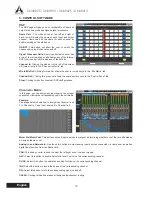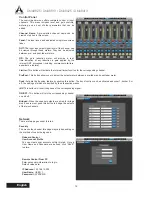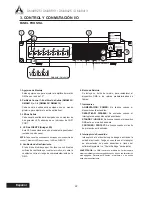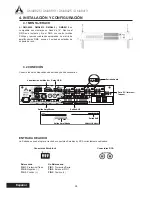
14
DMA8825 / DMA8813 / DMA8425 / DMA8413
English
Global In On/Off
This menu provides each individual button input, including
the analog inputs, network inputs, AES/EBU inputs and
signal generator�
Ducker
The ducker allows a signal to temporarily attenuate below
another signal when said signal activates the ducking
feature. This is useful when making announcements and
other such times when a signal needs to be heard clearly.
The ducker can be activated on input and output channels
by pushing the ‘Duck’ buttons found in the individual Matrix
control pages. There are two of these ‘duckers’ total on the
DMA�
Source:
This is used to select the source of the duck
function; i.e. the trigger signal. When the selected source’s
signal rises to a user-selected level, the currently selected
‘duck’ signals will attenuate at the selected level.
Threshold:
This determines the level that the source signal
needs to be before the ducking function will be activated.
Depth:
This determines how much the selected ‘duck’
signals will be attenuated.
Attack:
The attack time is the time it takes for the ducking feature to kick in after the source signal passes the selected threshold.
Release:
The release time control will determine the time the ‘duck’ feature will remain active as the source signal drops
back below the set threshold.
ALC – Auto Level Control
An autoleveler will allow users to dynamically change the
level of an input or output signal to match a predefined level
set by the user. The autolevel function can be activated for
each individual mix in the matrix pages� The settings for
these autolevelers can be found within this ALC menu.
In Target:
The target level setting allows users to select
the desired signal level for their autoleveler� All signals that
are processed by the autoleveler will essentially aim for the
target level�
Below Target:
The below target threshold of the autoleveler
is the point at which the autoleveler will kick in. Signals
below the threshold will not be affected, but signals above
will be have their gain increased.
Ratio:
The ratio is the input level change in decibels to the
output level change in decibels.
Increase Gain:
The increase gain determines the amount that the signal can be increased to meet the target level. This
helps prevent sudden, alarming changes in audio level.
Decrease Gain:
The decrease gain works the same as the decrease gain, but in reverse. It determines the amount a signal
can be cut.
Hold Time:
This determines the time the ALC will remain engaged after the signal falls back below the determined
threshold�
















































